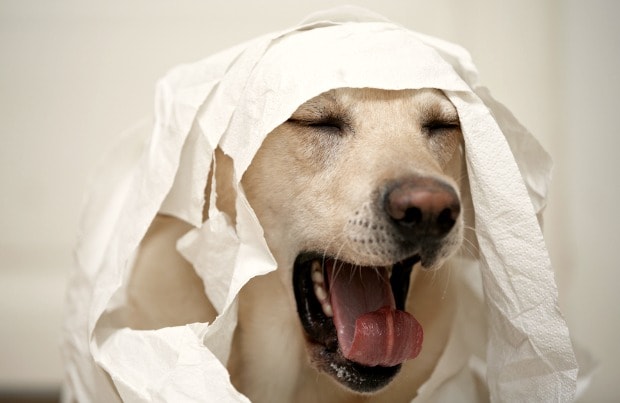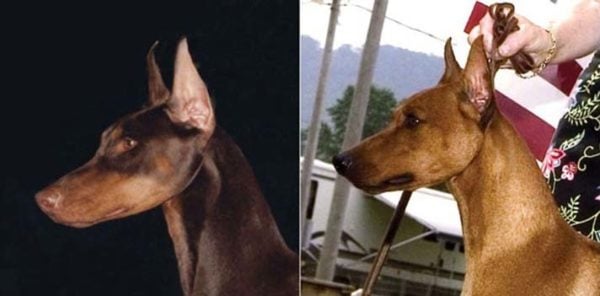Children and pets are responsible for many of life’s most embarrassing moments. But while kids can be told “please never do that again,” it’s much tougher to break pets out of awkward behaviors.
We polled pet parents on social media and asked them to submit the most embarrassing things their dogs have done around strangers. Then we consulted with experts—dog trainer Alyona DelaCoeur of the website Why Does My Dog?; Dr. Alison Birken Streit, a veterinarian and co-founder of Forever Freckled, a website dedicated to helping people with pets; and Brian Ogle, the lead anthrozoology instructor at Beacon College—to find out why these things happen and how to fix the cringe-worthy behaviors.
Awkward Pet Behavior #1: Butt Sniffers
Readers shared countless stories about pets sniffing the butts of other animals and people.
DelaCoeur: Dog’s butts have glands around them that act like a business card. Sniffing private parts is like following someone on social media. It is a way for pups to learn where they have been, what they have eaten and whether they are in heat.
Dr Ogle: This interaction is perfectly acceptable and normal in canine society. This is more of a human problem than a dog problem. However, you can redirect this behavior so the dog may follow acceptable human greeting standards.
For best results, have the dog sit and wait patiently for the human to greet the dog and offer a reward for the positive interaction. If the dog insists on sniffing, your strong “leave it” cue should be used. If need be, redirect your dog’s attention with a toy or a treat.
Awkward Pet Behavior #2: Humping Around
Even more than butt sniffing, readers shared plenty of stories about their pets humping other animals, humans, and inanimate objects like stuffed animals and couch cushions.
Dr. Ogle: This often is not a sexually motivated behavior. Instead, it is often created out of a poorly socialized dog who cannot handle new situations or properly express excitement—such as going to the park or a new visitor coming over. Because it releases pent-up energy created by the situation, the dog finds it perfectly normal and will continue the behavior if not redirected. The first step is to find out what triggers the behavior. Once the trigger has been identified, working to avoid or eliminate the trigger may resolve the issue. However, training and exercise may also be used to help correct the problem.
DelaCoeur: Humping is another form of communication. Humping can be a signal to other dogs that they are ready to play or ready to get wild with them. It has not been shown in animal behavior that humping is associated with dominance behavior. Humping is also self-soothing to dogs. When a dog is stressed or overwhelmed, they sometimes revert to humping others or their toys to relieve stress.
Awkward Pet Behavior #3: The “Crotch Punch”
An excited pet jumps up on a stranger and inadvertently hits the person in the crotch.
Dr. Streit: Many of these strange behaviors are natural for a dog but some are learned behaviors, such as jumping up on people, and a dog needs to be taught otherwise. The key for all undesired behaviors with pets is basic obedience training. Training pet parents how to obedience train is the first step. Learning how to teach your dog basic commands is the beginning of the end of those embarrassing public acts! Once your dog understands when you are not happy with something they are doing—such as jumping up—they will stop.
Awkward Pet Behavior #4: Barking At Loud Noises
The issues range from barking at other animals to loud sounds on the TV like phones ringing or sirens.
DelaCoeur: Howling and barking are forms of communication. Your pup is simply saying “hey, I own this spot” or “I am here, where are you?”
Dr. Ogle: The television in general can be difficult for dogs as they are hearing and seeing life-like images and sounds, which can be confusing or frightening to them. One of the best tricks to avoid issues with the TV and your dog is to associate mealtime with your TV time. Rewarding the calm behavior through dog food will quickly set a pattern as well as your expectation for the behavior.
Another great option is keeping your dog busy during TV time. Playing with favorite toys or a favorite game while the television is on will help to provide a distraction from the activities on the screen. This will often keep the dog from reacting to what is going on.
Awkward Pet Behavior #5: Nosey Pets
Many pet parents expressed issues with pets rummaging through places they shouldn’t, especially inside bags or packages. “We also had a dog that would go through our guests suitcases,” said one reader, “and one time he came walking downstairs wearing someone’s thong.”
DelaCoeur: Dogs are naturally curious creatures—they can follow their noses into all sorts of things, including trouble. We do not fully understand what kind of information they get from smelling, but we do know that they experience their world through scent. If this is an issue, I would suggest not leaving things out for your dog to go through. If you find your dog nosing through your belongings, practice a command, such as “leave it.” In this command you would say “leave it” and have your dog come to you to get a reward.
Awkward Pet Behavior #6: Feces Eaters
Several pet parents recounted stories of their dogs eating their own excrement. “My dog, a beagle, used to eat his own feces as it came out of him,” explained one of the pet parents we talked to. Ummmm….gross.
DelaCoeur: The odds are your dog really likes the taste of it. Some dogs eat poop to help with nutritional replacement. It might not seem like it, but dogs like their environment clean, so they might be “cleaning” up after themselves. In the wild, dogs will eat poop to clean their homes and to remove the smell that might attract other animals.
Dr. Streit: You are not alone—some dogs eat poop. I hear about it often. This is known as copraphagia. While we should understand that this act is sometimes natural for dogs, it can be quite embarrassing for pet parents. As puppies, dogs will eat their mother’s poop, and then sometimes their own. This sometimes continues through puppyhood. I always tell my clients that about 98 percent of the puppies simply grow out of it, but there is a possibility for this behavior to continue into adulthood. As always, the key for all undesired behavior with pets is basic obedience training.
Start by walking your pet on a dog leash to go outside, rather than letting him have free roam of a backyard. This way you can monitor the undesired behavior more closely, and make immediate reprimands using positive reinforcement training. With time and consistency, your pet will probably stop the undesired act.
Awkward Pet Behavior #7: Afraid Of Certain Ethnicities
While we highly doubt dogs have racist tendencies, some pups do act out around people of difference ethnicities. And this can be a big problem for pet parents who are trying to get along with neighbors and friends. “This is really awful,” shared one dog owner, “but our rescue dog intensely dislikes a specific ethnicity and displays his dislike quite obviously. It is the most embarrassing thing ever.”
Dr. Ogle: This is usually a lack of proper socialization, not necessarily a lack of training. If animals have not been properly exposed to different individuals during their critical development periods, they can become fearful.
One recommendation is to introduce puppies to 100 different people during their first 100 days. Make sure every type of person is interacted with. This will reduce fearfulness displayed when meeting individuals who are different from you or have different physical features than yourself.

Chris Illuminati is an author, blogger, and stand-up comic whose work has appeared in Rolling Stone, BroBible, Men’s Health, and many other publications.
Share:









